AMD Radeon HD 6850 Overclocking Roundup: Asus, XFX, & MSI
by Ryan Smith on November 8, 2010 12:40 AM ESTOverclocking: Performance, Power, Temperature, & Noise
Half of our results focus on our 6850s at their stock clocks, but the other half of our results focus on the card when it comes to overclocking. As a lower clocked Barts card, 6850 cards not binned for poor maximum clocks should have a fair bit of overclocking room as AMD intended for the design to hit 900MHz+. The 6850’s power efficiency pretty much has to go out the window here, but in return we can capture some significant performance gains.
| Overclocking Results | ||||||
| Stock Clock | Max Overclock | Stock Voltage | Max Overclocked Voltage | |||
| Radeon HD 6850 Reference | 775MHz | 940MHz | 1.094v | 1.172v | ||
| XFX Radeon HD 6850 | 775MHz | 940MHz | 1.148v | 1.172v | ||
| MSI R6850 OC | 820MHz | 960MHz | 1.148v | 1.22v | ||
| Asus EAH6850 | 790MHz | 960MHz | 1.148v | 1.22v | ||
When overclocking, we found 3 things:
- All of the cards could hit 850MHz core at stock voltage
- All of the cards could hit 940MHz core at 1.172v, the 6870 load voltage
- We had to give the cards significantly more voltage to get above 940MHz. This culminated at 1.22v on the Asus and MSI cards for 960MHz
Based on these results we went ahead and benchmarked the Asus card at 850/1150, 940/1150, and 960/1150 to showcase the performance at these overclocks, while capturing data for all of the cards at 1.172v, and the Asus and MSI cards at 1.22v.
While it’s possible to hit 960MHz with enough voltage, in practice it’s not worth the effort. The Asus and MSI cards jumped in power consumption, temperature, and noise by around 20W, 3C, and 2dB each, for a performance difference of under 2%. On a higher-end card where performance is the only attribute that matters this wouldn’t really matter, but we would not consider this a useful tradeoff on a petite card like the 6850.
As for memory overclocking, we hit at solid wall at 1150MHz as none of our cards could do 1200MHz without artifacting. However 1150MHz didn’t trigger performance degradation due to error correction-induced retransmission, so it looks to be a safe frequency for all cards. The limit we believe lies solely with the memory controller, which was a conscientious decision by AMD to trade memory clocks for a smaller die. As a result the controller reaches its limit before we can even push the 5GHz GDDR5 to spec.
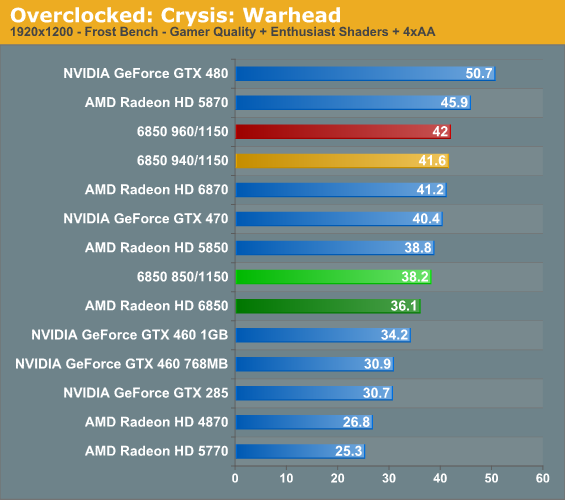
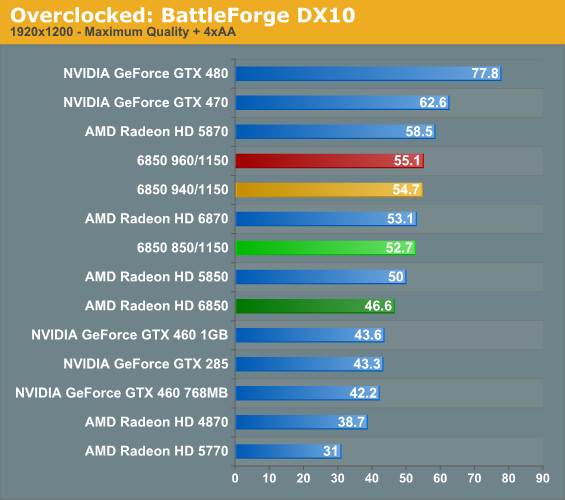


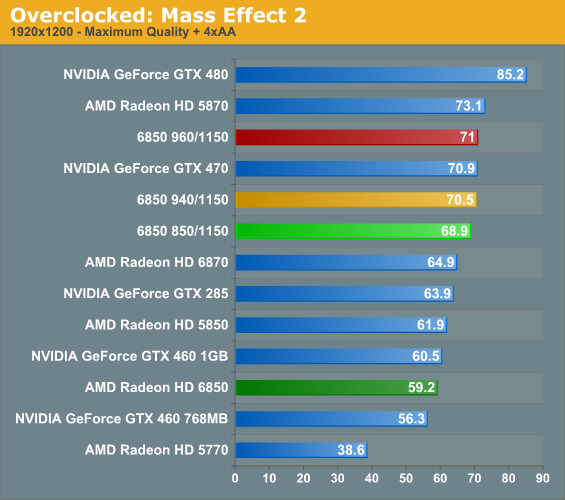
Something that caught us completely off-guard in our results is just how well the overclocked 6850 did. Even at the “mere” speed of 850/1150, it’s faster than the 6870 in 3 out of our 5 games; and the 6870 still has a core clockspeed advantage and more SIMDs! The advantage for our overclocked 6850s is that the memory clock of 1150MHz (4.6GHz effective) is faster than the 6870’s memory clock of 1050Mhz (4.2GHz effective), and this looks to be the reason for the difference. Based on all the data we have, Barts looks to be memory bandwidth starved in around half the games we use. From this it looks like a good memory overclock is going to go a long way on the 6850 and 6870 towards improving performance.
As for how much of an overclock is necessary, this depends on the game. When Barts is memory bandwidth starved, the 940Mhz and 960Mhz memory overclocks provide only a small boost; while on shader-bound games like Crysis there’s a very tangible benefit. Combine the memory overclock with a 940Mhz core overclock and the 6850 can meet or beat the 6870 every single time. The voltage increase necessary to achieve this core overclock comes at a price however.

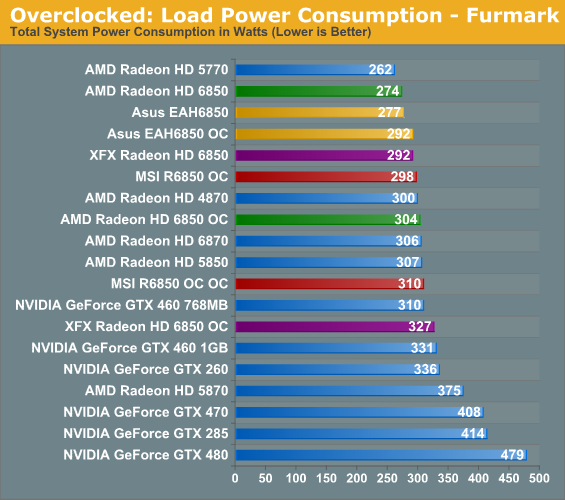
Starting with power consumption, the voltage increase necessary for 940MHz is around 20W-30W under FurMark for our reference and near-reference clocked cards, and less for the MSI card since it already has a notable factory overclock. If nothing else, 1.172v gives up all the power advantages over the Radeon 5850, though as we’ve seen it pays off with a very notable performance advantage over the 5850.
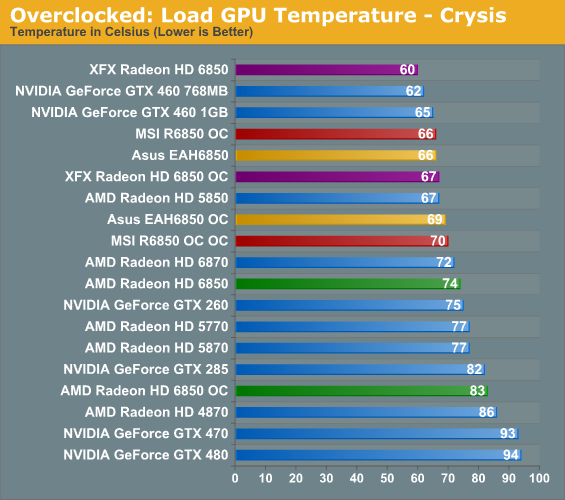

For the partner cards in today’s roundup, the temperature runup from overvolting isn’t too bad, with the worst card only hitting 81C under FurMark and becoming progressively cooler from there. However the reference 6850 is an entirely different story: it hits 93C under FurMark, which is hotter than what we’re comfortable with for Barts, particularly since it’s brand new. If reference-style cards show up on the market, we would not recommend overvolting them, at least not to 1.172v. Meanwhile the XFX card with its focus on temperature tops this chart, still only hitting 74C under FurMark. The cooling on this card is so good that we suspect the VRMs will burn up long before the GPU will when overvolting.
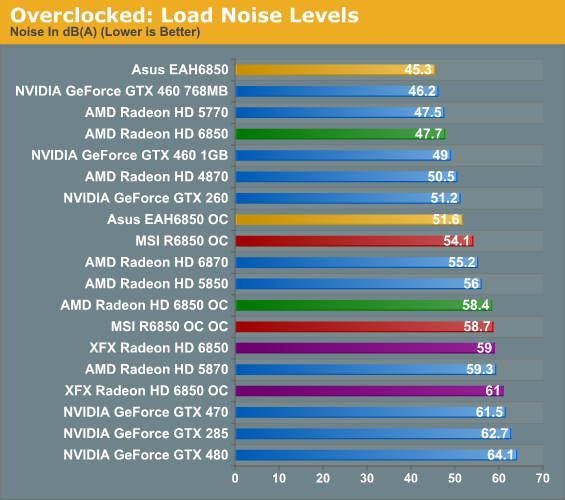
Finally we come to noise. We suspect many buyers will be alright with the power and temperature increases so long as noise remains manageable, so what we have is a mixed bag. Throwing out the reference 6850, we’re left with the XFX card at over 60dB, and while XFX’s focus on temperatures is commendable, it ends up being shortsighted by making the card exceptionally loud here. This is followed by the double-overclocked MSI card, which at 58.7dB is over 3dB louder than the 6870, but is only encroaching on the 5870. It’s too much noise for the performance, but compared to first-gen 40nm cards it’s not the end of the world.
This leaves us with the Asus card. While it does jump by 6dB due to our overclocking, it had such a massive lead at stock that this only makes it about as loud as the GTX 260 and Radeon HD 4870. The idea of a near-silent card has gone out the window at this point, but we would consider it a very manageable level of noise for the performance offed with the 940/1150 overclock. Certainly it’s the most balanced of the cards, as it sacrifices only little in the way of cooling (78C in FurMark) for the lower level of noise generated.










93 Comments
View All Comments
CeriseCogburn - Thursday, August 23, 2012 - link
The "new policy" purportedly made from "abundantly clear emails" is a self serving policy and will leave us with less information more of the time.Anandtech will include only the OC model of the currently being tested card, and thus - they will get a happy pat on the head for the review article from their minders who sent them the test card(s).
Oh look it's soooo fast...
"why thank you"
"your welcome"
"see you guys at the island party where we can discuss the industry"
"why thanksfor the tickets and invite !"
"you're welcome keep up the good promo work!"
"we will ! "
"I like how you said it's your viewers desire! Man the spin is awesome !"
7Enigma - Monday, November 8, 2010 - link
I can't say I read all 55 pages (last time I checked), but if you weeded out the fanboys on both sides you got very similar to what the OP is saying here (and I'm sure the comments to follow will reiterate):Comparing stock-clocked cards from a LAUNCH article of a new series to OC variants is questionable (again the key word being launch), but I believe that few of us were asking to not have any factory OC cards included (especially when this review focuses solely ON factory OC cards).
Just keep the comparisons consistent; that's all most of us readers without an agenda are advocating.
mm2587 - Monday, November 8, 2010 - link
Thank you. I admit my first post was a bit over the top but really so was the conclusion to this article.Here's an article about the extremes of the 6850. A perfect place to mention the extremes of its closest competitor the gtx460 (yes the ftw cost more, but lets face it most 460's are able to clock within 5% of the ftw)
Instead we're treated with another round of OC'd cards vs. reference cards. The very issue that created the uproar previously.
I have no agenda here. I'm pretty sure I've switched manufacturers every time I've updated my card. I just want the most bang for my buck regardless of what color the card is. Right now Anandtech's articles are not doing a good job of showing me how to get that.
I've used and trusted this site for years. Like 7enigma, all I'm asking for is consistency, something that I always thought this site delivered.
khimera2000 - Monday, November 8, 2010 - link
I have to agree i was surprised that the FTW card was not included since this was roundup of the 6850 OC cards. But i can understand there hesitation. When they caved to Nvidia they lost alot of respect from alot of there reviewers since no matter how you spin it, and no matter what there intentions everyone who looks at the sight will see it as AT selling out.AT now have to be even more carefull not to include anything that might be seen as biyest. and now has to do alot of work to prove that its loyalties rest with its readers and not lining there pockets (good luck)
If it was found that the FTW card killed the OC 6850 then im pritty sure they would have another flaim fest.
Its not a perfect approach but I see it as a step in the right direction to patching up there relation with there customer base. Id say a good approach is do a review off all the cards individualy so you can do see there marrets and flaws, then post one big comparison review of the OC 400 series vs the OC 6000 series. then note that you intend to do this comparison at the releas of every OC card.
MeanBruce - Wednesday, November 10, 2010 - link
Oh my God, you might have to start thinking on your own, what a disaster. Remember who is in charge here, Anand, not you...krumme - Monday, November 8, 2010 - link
Excellent Ryan.Thank you for listening.
flipmode - Monday, November 8, 2010 - link
Well, Ryan - give the people what they want, right? So you're giving in to the Radeon fanboys and opting to limit the products that you show. I don't know what to say. Sometimes you have to stand up to fanboys and stupidity, not give in. Anandtech just got an F for the day today.You're simply not supposed to let fanboys dictate policy for you.
mapesdhs - Monday, November 8, 2010 - link
Hey, wait a minute Ryan, *plenty* of us said we _did_ agree with including
the FTW, that it was the right thing to do. You're seriously bowing to the moaners?
That's effectively admitting your original rationale for including the card was
wrong, which makes no sense to me.
As I pointed out, people who objected are much more likely to say so than
people who didn't mind. So once again we have to pander to the lowest
common denominator of opinion?
You should do a particular thing because it is the _right_ thing to do, not
because the majority say so. An opinion without a rationale is no opinion
at all. Your reasons for including the FTW were sound; it should have been
included in this review precisely to offer the comparison which all those
same moaners said was missing in the earlier article. It's whatt hey wanted
afterall.
What a sad day... another win for the those who shout loudest. :\
Ian.
medi01 - Monday, November 8, 2010 - link
Right thing to do was exactly NOT including cherrypickedhardtofindoverclocked card. They realize it themselves.SlyNine - Monday, November 8, 2010 - link
Wait wait. Can we please respect the opinions of others instead of having an "my opinion is the only valid one" Now I agreed with their decision to include the FTW. But it's no big deal that they don't.Otho I agree, It sucks that those who whine loudest get their gears greased first. But if it's not a big deal, who gives a rats @$$.